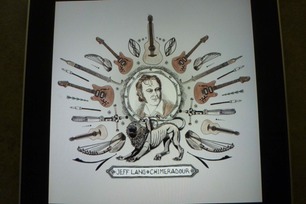Monday, 6 May 2013

It’s an ill wind that blows no one any good, and while I’d prefer if iTunes didn’t decide tracks I know have been played a number of times have a play count of zero (though the date on which they were last played appears in the relevant column of the player window), on the occasions when it decides to do that with a whole album, it provides a gentle prod towards something I probably haven’t listened to in a while.
I’ll eventually get around to giving the Jeff Lang albums in the collection a serious going back over, and since iTunes decided to do its little trick with 2009’s Chimeradour here’s one that gets the treatment sooner rather than later. By this point, with half a dozen solo (studio) albums, collaborations with, among others Bob Brozman and Chris Whitley and another half dozen live recordings in a career that runs back to 1994 Lang’s an established artist and had moved from an itinerant existence living in his van between gigs to married life with a child and a shed at the back of the yard he can retreat to for writing purposes.
A glance at the collaborations in the Discography suggests a sense of adventure, and recent collaborations with Malian kora player Mamadou Diabaté are fairly obvious throughout Chimeradour, and that combination of chimera and troubadour is a rather accurate portrayal of Lang’s style and inclinations.
A glance at the Dictionary app on my Mac reveals three definitions for chimera. From Greek mythology we have a fire-breathing female monster with a lion's head, a goat's body, and a serpent's tail, a sense that might move those of us with an inclination to the fanciful to wax poetic about the guitar pyrotechnics. Second, there’s a thing that is hoped or wished for but in fact is illusory or impossible to achieve, which could well be the average listener’s reaction to those pyrotechnics and in the biological sense we have an organism containing a mixture of genetically different tissues, formed by processes such as fusion ..., grafting, or mutation, and if that’s not an accurate description of Lang’s eclectic technique I don’t know what is.
Again, I’d point the reader towards the West African and sub-Saharan elements in Two Worlds and Home To You, wafting and caressing before a much more frenetic I Want To Believe with Lang over a manic fingerpicked double time guitar riff. I Don't Like Him Being In Here comes right out of Richard Thompson territory, with a guitar solo to match and feels like The End Of The Rainbow (covered later in the running list) brought on a couple of years and told from the little horror’s point of view with the kid, dealing with what presents as a dysfunctional family, failing to comprehend what’s happening around him or the reasons why it’s happening.
There’s a touch of the Moroccan Casbah about Edge Of The Light, a solid dose of Crazy Horse style Neil Young meets Jimi Hendrix in Slow Rooms + Fast-Blurred Faces and a healthy serve of desert blues in South‘s rolling riff.
Social issues come to the fore in Another One Of Those Days’ portrayal of an abused wife that hints at murder or some form of malfeasance while Richard Thompson’s The End Of The Rainbow, one of the bleakest songs known to Western civilization gets a suitably chilling delivery that follows on nicely from the menacing undertones of the previous track. After that you need at least a glimmer of light in the darkness, and while Half A Tank Of Hope isn’t exactly upbeat, it fits the bill and Things Are Coming Back My Way is in much the same hemisphere. Not quite upbeat, but headed in that direction. Possibly.